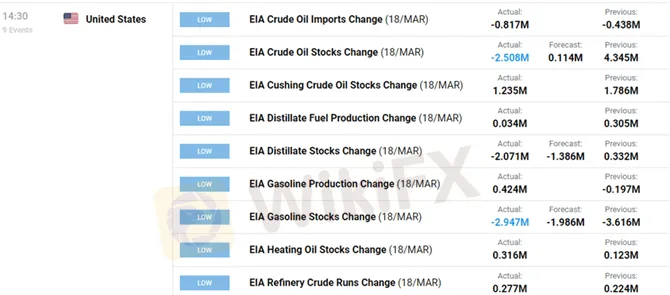简体中文
繁體中文
English
Pусский
日本語
ภาษาไทย
Tiếng Việt
Bahasa Indonesia
Español
हिन्दी
Filippiiniläinen
Français
Deutsch
Português
Türkçe
한국어
العربية
CRUDE OIL PRICE TALKING POINTS
Abstract:The price of oil trades to a fresh weekly high ($115.40) amid an unexpected decline in US inventories, and crude may continue to retrace the decline from the yearly high ($130.50) if the Organization of Petroleum Exporting Countries (OPEC) stick to the current production schedule at the next Ministerial Meeting on March 31.
Crude Oil Price Outlook Hinges on OPEC Meeting
CRUDE OIL PRICE OUTLOOK HINGES ON OPEC MEETING
The price of oil appears to have reversed ahead of the 50-Day SMA ($95.32) as it extends the series of higher highs and lows carried over from last week, and current market conditions may keep crude prices afloat as data prints coming out of the US point to strong demand.

US stockpiles narrowed 2.508M in the week ending March 18 versus forecasts for a 0.114M rise, and the development largely align with the upbeat outlook entailed in OPECs most recent Monthly Oil Market Report (MOMR) as the update insists that “for the time being, world oil demand growth in 2022 remains unchanged at 4.2 mb/d, given the high uncertainty and extreme fluidity of developments in recent weeks.”
Indications of robust demand may encourage OPEC and its allies to retain the current production schedule with the group on track to “adjust upward the monthly overall production by 0.4 mb/d for the month of April 2022,” and the decline from the yearly high ($130.50) may turn out to be a correction in the broader trend as US production remains subdued.

A deeper look at the update from the Energy Information Administration (EIA) show weekly field production holding steady for seven consecutive weeks, with the figure printing at 11,600K in the week ending March 18, and more of the same from OPEC+ may ultimately lead to higher oil prices as the group retains a gradual approach in restoring production to pre-pandemic levels.
With that said, the price of oil may continue to carve a series of higher highs and lows ahead of the OPEC meeting as indications of stronger demand are met with signs of limited supply, and crude may stage another attempt to test the record high ($147.27) if the group shows little interest in responding to the Russia-Ukraine war.

Disclaimer:
The views in this article only represent the author's personal views, and do not constitute investment advice on this platform. This platform does not guarantee the accuracy, completeness and timeliness of the information in the article, and will not be liable for any loss caused by the use of or reliance on the information in the article.
Read more

President of Liberland Vít Jedlička Confirms Attendance at WikiEXPO Hong Kong 2025
Vít Jedlička, President and Founder of the Free Republic of Liberland, has confirmed his participation in WikiEXPO Hong Kong 2025, one of the most influential Fintech summits in the industry. The event will bring together global leaders, innovators, and policymakers to delve into the future convergence of technology and society.

Is Billion Bucks Fx Scam?
Recent claims on YouTube and social media platforms allege that Billion Bucks Fx is a scam broker. Many traders have reportedly lost money after investing with this broker, and it has been given a notably low score of 1.06/10 by independent rating platforms. In this article, we break down the details of Billion Bucks Fx, assess the risks, and provide insight into whether investors should be wary of its services.

SocialFi and the Forex Market: A New Era for Decentralized Social Trading?
The worlds of social media and decentralized finance (DeFi) have converged under a new banner—SocialFi. Short for “Social Finance,” SocialFi leverages blockchain technology to reward user engagement, giving individuals direct control over their data and interactions. While SocialFi has primarily emerged in the context of content creation and crypto communities, its principles could soon revolutionize the forex market by reshaping how traders share insights and monetize social influence.

Do This ONE Thing to Transform Your Trading Performance Forever
The story is all too familiar. You start trading with high hopes, make some quick profits, and feel like you've finally cracked the code. But then, just as fast as your gains came, they disappear. Your account balance dwindles, and soon you’re left wondering what went wrong. Worse still, fear and confusion creep in, making every new trade a stressful gamble rather than a calculated decision. If this cycle sounds familiar, you’re not alone.
WikiFX Broker
Latest News
Forex Market Outlook: Key Currency Pairs and Trading Strategies for March 24–28, 2025
Singapore Police Crack Down on Scams: $1.9M Seized, 25 Arrested
Gold Prices Swing Near Record Highs
XTB Opens New Dubai Office
Africa Cybercrime Bust: Over 300 Arrested in Fraud Crackdown
The Growing Threat of Fake Emails and Phishing Scams
Hong Kong Banks and Authorities Collaborate to Freeze Fraudulent Accounts Faster
SocialFi and the Forex Market: A New Era for Decentralized Social Trading?
Is Billion Bucks Fx Scam?
BaFin Halts USDe Token Issuance, Citing Serious Compliance Failures
Currency Calculator







